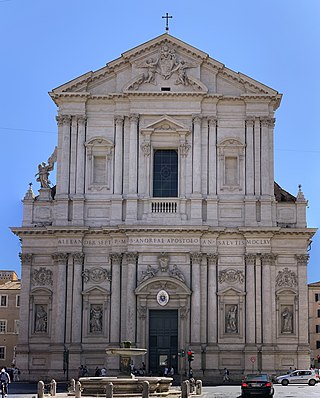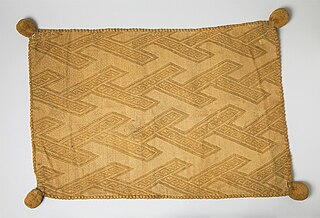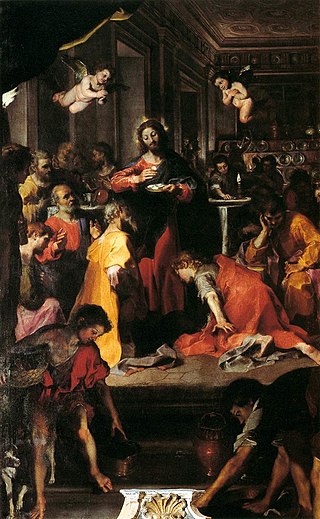
Antonio Emanuele Ne Vunda, also known as Antonio Manuel Nsaku Nvunda (or Vunta or Funda; died 1608), was an ambassador from the Kingdom of Kongo to the Vatican.

Antonio Emanuele Ne Vunda, also known as Antonio Manuel Nsaku Nvunda (or Vunta or Funda; died 1608), was an ambassador from the Kingdom of Kongo to the Vatican.
Ne Vund was sent as ambassador by King Álvaro II in 1604. [1] [2] Ne Vunda traveled through Brazil and Spain and only reached Rome on 3 January 1608, but he died two days later of illness. [3] [1] He was the first African ambassador to the Holy See.
A bust of Ne-Vunda made in colored marble can be seen at Santa Maria Maggiore, by Francesco Caporale in Rome. [4]
A painting of Ne Vunda is visible in the Sala dei Corazzieri, Palazzo del Quirinale in Rome, next to a painting depicting the 1615 embassy of Hasekura Tsunenaga from Edo Japan.

Michelangelo Merisi da Caravaggio, known mononymously as Caravaggio, was an Italian painter active in Rome for most of his artistic life. During the final four years of his life, he moved between Naples, Malta, and Sicily until his death. His paintings have been characterized by art critics as combining a realistic observation of the human state, both physical and emotional, with a dramatic use of lighting, which had a formative influence on Baroque painting.

Battle of Mbwila occurred on 29 October 1665 in which Portuguese forces defeated the forces of the Kingdom of Kongo and decapitated king António I of Kongo, also called Nvita a Nkanga.

Sant'Andrea della Valle is a minor basilica in the rione of Sant'Eustachio of the city of Rome, Italy. The basilica is the general seat for the religious order of the Theatines. It is located at Piazza Vidoni, at the intersection of Corso Vittorio Emanuele and Corso Rinascimento.

Andrea Sacchi was an Italian painter of High Baroque Classicism, active in Rome. A generation of artists who shared his style of art include the painters Nicolas Poussin and Giovanni Battista Passeri, the sculptors Alessandro Algardi and François Duquesnoy, and the contemporary biographer Giovanni Bellori.

Álvaro I Nimi a Lukeni lua Mvemba was a Manikongo, or king of Kongo, from 1568 to 1587, and the founder of the Kwilu dynasty.

Antonio Mancini was an Italian painter.

The Basilica of Saint Augustine in Camp Martius, commonly known as Basilica of Saint Augustine is a Roman Catholic minor basilica in Rome. The titular church is dedicated to Saint Augustine of Hippo and serves as the motherhouse of the Augustinian Order.

San Pietro in Montorio is a church in Rome, Italy, which includes in its courtyard the Tempietto, a small commemorative martyrium ('martyry') built by Donato Bramante.

The Kingdom of Kongo was a kingdom in Central Africa. It was located in present-day northern Angola, the western portion of the Democratic Republic of the Congo, Southern of Gabon and the Republic of the Congo. At its greatest extent it reached from the Atlantic Ocean in the west to the Kwango River in the east, and from the Congo River in the north to the Kwanza River in the south. The kingdom consisted of several core provinces ruled by the Manikongo, the Portuguese version of the Kongo title Mwene Kongo, meaning "lord or ruler of the Kongo kingdom", but its sphere of influence extended to neighboring kingdoms, such as Ngoyo, Kakongo, Loango, Ndongo, and Matamba, the latter two located in what is Angola today.

The Basilica of St. Stephen in the Round on the Caelian Hill is an ancient basilica and titular church in Rome, Italy. Commonly named Santo Stefano Rotondo, the church is Hungary's "national church" in Rome, dedicated to both Saint Stephen, the first Christian martyr, and Stephen I, the canonized first king of Hungary. The minor basilica is also the rectory church of the Pontifical Collegium Germanicum et Hungaricum.

Álvaro II Nimi a Nkanga was king of Kongo from 1587 to 1614. He was one of Kongo's most powerful and important kings, who succeeded his father Álvaro I, but not until resolving a dispute with his brother. Both sides brought armies to M'banza-Kongo but to avoid bloodshed they agreed to single combat, won by Álvaro.

The Catholic Church arrived in the Kingdom of Kongo shortly after the first Portuguese explorers reached its shores in 1483. Portuguese left several of their own number and kidnapped a group of Kongo including at least one nobleman, Kala ka Mfusu, taking them to Portugal where they stayed a year, learned Portuguese and were converted to Christianity. The group was returned to Kongo in 1485 and Kala ka Mfusu led a royal mission from Kongo's manikongo, Nzinga a Nkuwu to Portugal. Following their arrival in late 1486 the embassy stayed nearly four years in Lisbon with the monks of Saint John the Baptist. There they studied Christianity and Portuguese with Vicente dos Anjos, and began the start of a Kongolese version of Christianity.

Mvemba a Nzinga, Nzinga Mbemba, Funsu Nzinga Mvemba or Dom Alfonso, also known as King Afonso I, was the sixth ruler of the Kingdom of Kongo from the Lukeni kanda dynasty and ruled in the first half of the 16th century. He reigned over the Kongo Empire from 1509 to late 1542 or 1543.
Cipriano Efisio Òppo was an Italian painter, stage designer, satirical illustrator, and critic. He was born in Rome, the city in which he also lived, worked and died, though his father's and mother's families had both come originally from Sardinia. He was an influential and perceptive commentator and mentor in respect of the Italian art scene through the challenges of the Mussolini years.

Giovanni Doria, called Giannettino, the son of Giovanni Andrea Doria, 6th Prince of Melfi, and Princess Zenobia Doria del Carretto, 5th Princess of Melfi.

Gaspare Murtola was an Italian poet and writer of madrigals. He is known for a bitter literary feud with Giambattista Marino, carried out "with sonnets, invectives, and pistol shots," and for references he makes in his poetry to art works by Caravaggio. His main work is the sacred poem La Creazione del mondo.

In the Kongo Kingdom and its vassals, the woven arts were emblematic of kingship and nobility. The coarse filament stripped from the fronds of the raffia palm tree served as the foundation of the Kongo weaving arts. This material imposed constraints that were overcome to produce varied and ingenious textile formats and structures. Raffia cloth was used as currency.

The Communion of the Apostles, or Institution of the Eucharist is a painting of the Last Supper by Federico Barocci located at Santa Maria sopra Minerva in Rome. It was commissioned for the family chapel of Pope Clement VIII Aldobrandini and completed between 1603 and 1608.
The Royal Council of the Kingdom of Kongo was the governing body of officials and nobles of the Kingdom of Kongo from the 15th to 17th century. In theory, the king could not declare war, make or take appointments, and open or close roads without the consent of this council.
Ana Afonso de Leão was the queen regnant of the Kingdom of Nkondo between 1673 and 1710. She conquered the territories of Lemba and Matari, as well as those located along the Mbidizi river in the Kingdom of Kongo in the 17th century. She was a decisive figure during the Kongolese civil war.